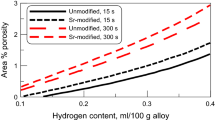Abstract
A number of alloys, notably most of the aluminum alloys, can be heat treated by aging. This aging due to time-dependent precipitation hardening increases the strength and hardness as well as modifying other mechanical properties. Precipitation hardening has been a popular strengthening mechanism for many decades; therefore, extensive information is available in literature about the precipitation-hardening response of various series of aluminum alloys. The age-har dening response of these alloys is usually represented in graphical form as plotted between property changes and aging time for different temperatures. In designing a suitable precipitation-hardening strategy, one can refer to these graphs. However, for automatic control of aging furnaces, as well as for decision making regarding optimal selection of aging conditions (time/temperature combination), it is desirable to express these relationships in a formal mathematical structure. A mathematical model is developed in this article for widely used heat treatable aluminum alloys used in the extrusion industry. This model is a condensed representation of all σ=f(T, t) curves in different series of aluminum alloys, and the parameters of this model characterize the various compositions of the alloys in the series.
Similar content being viewed by others
References
R. Ramanan and A. Dery, How to Obtain the Most from Your Aging Oven, Proc. Sixth Int. Aluminum Extrusion Technology Seminar, Vol 1, The Aluminum Association Inc., 1996
I. Musulin and D. Dietz, Selection of 6xxx Alloys Based on Extrudability, Properties and Final Usage, Proc. Fifth Int. Aluminum Extrusion Technology Seminar, Vol 1, The Aluminum Association Inc., 1992
I.J. Polmear, Light Alloys: Metallurgy of the Light Metals, Edward Arnold, London, 1989
R. Akeret, AlMgSiO.5-High Speed Extrusion Alloys, Proc. Fifth Int. Aluminum Extrusion Technology Seminar, Vol 1, The Aluminum Association Inc., 1992
C.R. Brooks, Heat Treating of Aluminum Alloys, Heat Treating, ASM Handbook, 1991, p 841–848
S.C. Bergsma, M.E. Kassner, X. Li, M.A. Delos-Reyes, and T.A. Hayes, The Optimized Mechanical Properties of New Aluminum Alloy AA6069, J. Mater. Eng. Perform., Vol 5 (No. 1), 1996, p 111–116
E.E. Lewis, Introduction to Reliability Engineering, John Wiley & Sons, 1996
J.V. Rijkom and W.S. Miller, Improved Properties of Extruded Products by Heat Treatment, Proc. Sixth Int. Aluminum Extrusion Technology Seminar, Vol 1, The Aluminum Association Inc., 1996
Author information
Authors and Affiliations
Rights and permissions
About this article
Cite this article
Qureshi, F.S., Sheikh, A.K. & Rashid, M. A mathematical model to predict the strength of aluminum alloys subjected to precipitation hardening. J. of Materi Eng and Perform 8, 353–360 (1999). https://doi.org/10.1361/105994999770346918
Received:
Revised:
Published:
Issue Date:
DOI: https://doi.org/10.1361/105994999770346918




